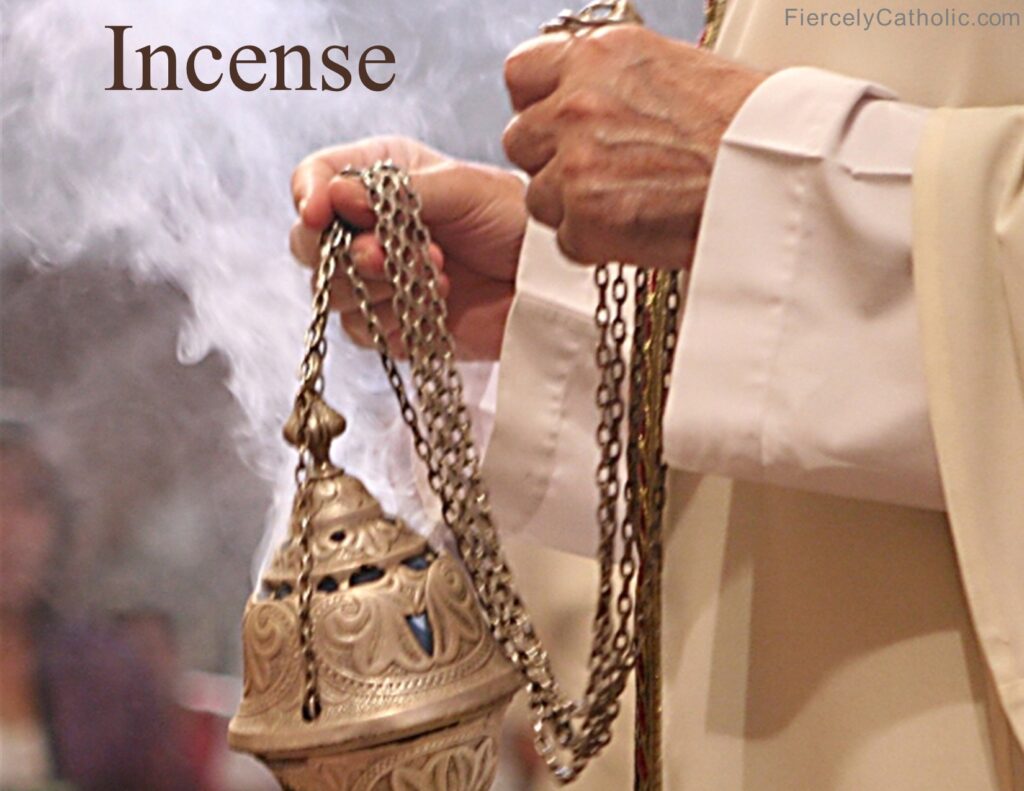
The burning of incense is an ancient tradition that Christians learned from the Jewish people. For Catholics, burning incense is an offering to God, and a sign of prayers being offered and ascending up to Heaven.
Commanded by God Himself, the use of incense for worship, cleansing, and sanctification is mentioned around 170 times throughout the Bible, in both the Old and New Testaments.
Burning incense produces smoke and gives off a sweet smell, symbolizing that something pleasant and acceptable is being offered to God. In the past, incense was expensive and scarce so burning it was a true sacrifice.
In the Old Testament, Moses is commanded to use a specific blend of incense for purification and worship in the tabernacle. The Book of Psalms connects the use of incense with prayer.
In the Gospel of Matthew, frankincense was one of the gifts brought for the infant Jesus by the Magi, indicating his role as priest. In the Book of Revelation, incense rose to God’s heavenly throne with the prayers of the saints.
In today’s Catholic liturgical services, incense is burned while offering prayers, when blessing people and objects, and while worshiping God.
Smelling incense and seeing the smoke grabs people’s attention. By engaging more of the senses in this way, the minds and hearts of Catholic worshippers are more effectively directed toward God.
Incense is burned in a type of censor called a thurible, a small metal pot that hangs from a chain and holds hot coals. The grains of incense are stored in a sacred vessel called a boat and transferred into the thurible with a small spoon.
Sweet smelling smoke:
Making us aware of the incredible mystery right in front of us:
Engaging the senses to enhance the ritual ceremonies of the Church:
Another angel came and stood at the altar, holding a gold censer. He was given a great quantity of incense to offer, along with the prayers of all the holy ones, on the gold altar that was before the throne. The smoke of the incense along with the prayers of the holy ones went up before God from the hand of the angel. Then the angel took the censer, filled it with burning coals from the altar, and hurled it down to the Earth. There were peals of thunder, rumblings, flashes of lightning, and an earthquake.
Revelation 8: 3-5
The use of incense is scriptural:
Burning incense is a sacrifice to God:
Incense contributes to a deeper experience with God:
Symbolizing our prayer and God’s presence:
The liturgy of the Word is an integral part of sacramental celebrations. To nourish the faith of believers, the signs which accompany the Word of God should be emphasized: the book of the Word (a lectionary or a book of the Gospels), its veneration (procession, incense, candles), the place of its proclamation (lectern or ambo), its audible and intelligible reading, the minister’s homily which extends its proclamation, and the responses of the assembly (acclamations, meditation psalms, litanies, and profession of faith).
Catechism of the Catholic Church 1154
Incense is reserved for special religious practices:
An expression of reverence and prayer:
In the community celebration of the Divine Office, the gesture of incensing the altar, the priest and the people while the Gospel Canticles are being sung, is reminiscent – in light of the Hebrew tradition of offering incense morning and evening on the altar of incense – of the sacrificial character of the “sacrifice of praise” expressed in the Liturgy of the Hours. Surrounding Christ in prayer, may we be able to live personally what is said in the Letter to the Hebrews: “Through him, then, let us continually offer up a sacrifice of praise to God, that is, the fruit of lips that acknowledge his name.”
Pope John Paul II, General Audience, 15 October 2003
The use of incense in the Eastern Catholic Churches is more prominent:
The Truth, Goodness, and Beauty of the Catholic Church
A place reserved exclusively for the worship of God:
Share this page with friends and family to start a conversation about your faith.
Don’t miss a post. Learn more about the Catholic Church and strengthen your Catholic faith.
Find more Fiercely Catholic video issues here.
Subscribe here.



